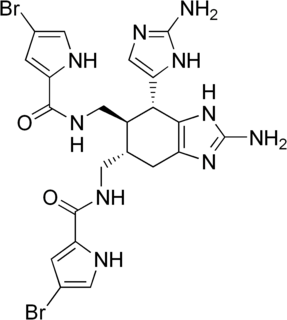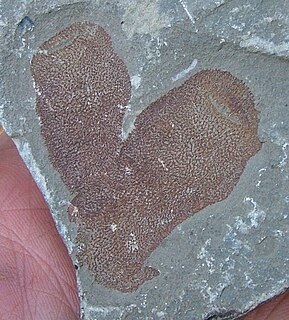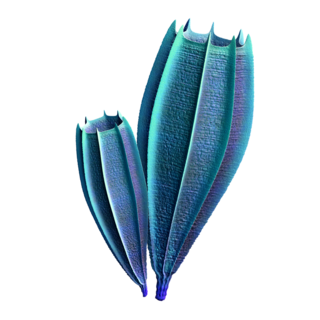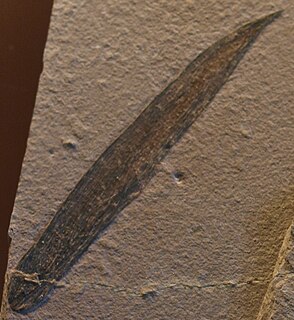
Ageliferin is a chemical compound produced by some sponges. It was first isolated from Caribbean and then Okinawan marine sponges in the genus Agelas. It often co-exists with the related compound sceptrin and other similar compounds. It has antibacterial properties and can cause biofilms to dissolve.

Hazelia is a genus of spicular Cambrian demosponge known from the Burgess Shale, the Marjum formation of Utah, and possibly Chengjiang. It was described by Charles Walcott in 1920.

Takakkawia is a genus of sponge in the order Protomonaxonida and the family Takakkawiidae. It is known from the Middle Cambrian Burgess Shale that reached around 4 cm in height. Its structure comprises four columns of multi-rayed, organic spicules that align to form flanges. The spicules form blade-like structures, ornamented with concentric rings.

Halichondrites, sometimes mis-spelt Halicondrites is an extinct genus of sea sponge known from the Middle Cambrian Burgess Shale. 7 specimens of Halichondrites are known from the Greater Phyllopod bed, where they comprise < 0.1% of the community.
Hamptonia is an extinct genus of sea sponge known from the Middle Cambrian Burgess Shale and the Lower Ordovician Fezouata formation. It was first described in 1920 by Charles Doolittle Walcott. 48 specimens of Hamptonia are known from the Greater Phyllopod bed, where they comprise < 0.1% of the community.
Leptomitus is a genus of demosponge known from the Middle Cambrian Burgess Shale. Its name is derived from the Greek lept ("slender") and mitos ("thread"), referring to the overall shape of the sponge. 138 specimens of Leptomitus are known from the Greater Phyllopod bed, where they comprise 0.26% of the community.
Pirania is an extinct genus of sea sponge known from the Middle Cambrian Burgess Shale and the Ordovician Fezouata formation. It is named after Mount St. Piran, a mountain situated in the Bow River Valley in Banff National Park, Alberta. It was first described in 1920 by Charles Doolittle Walcott. 198 specimens of Pirania are known from the Greater Phyllopod bed, where they comprise 0.38% of the community.
Pseudoalteromonas spongiae is a marine bacterium isolated from the sponge Mycale adhaerens in Hong Kong.
Streptomyces spongiae is a bacterium species from the genus of Streptomyces which has been isolated from the marine sponge Haliclona in Tateyama in Chiba in Japan.
Sphingomonas jejuensis is a Gram-negative, rod-shaped and non-motile bacteria from the genus of Sphingomonas which has been isolated from the sponge Hymeniacidon flavia near the Jeju Island in Korea.
Aquimarina spongiae is a bacterium from the genus of Aquimarina which has been isolated from the sponge Halichondria oshoro from the coastal area of Jeju in Korea.
Tsukamurella spongiae is a Gram-positive, rod-shaped, and non-spore-forming bacterium from the genus of Tsukamurella which has been isolated from a sponge from the coast of Curaçao in the Netherlands Antilles.
Protomonaxonida is an extinct order of sea sponges. It is a paraphyletic group gathering the most ancient species from the Burgess Shale to modern sponges.
Amphritea spongicola is a Gram-negative and rod-shaped bacterium from the genus of Amphritea which has been isolated from a marine sponge from Micronesia.
Mycale adhaerens, the purple scallop sponge, is a species of marine demosponge in the family Mycalidae. Mycale is a large genus and this species is placed in the subgenus Aegogropila making its full name, Mycale (Aegogropila) adhaerens. It grows symbiotically on the valves of scallop shells and is native to the west coast of North America.
Saccharopolyspora spongiae is a bacterium from the genus of Saccharopolyspora which has been isolated from the sponge Scopalina ruetzleri.
Mangrovimonas xylaniphaga is a bacterium from the genus of Mangrovimonas which has been isolated from mangrove sediments from the Matang Mangrove Forest in Perak.
Mangrovimonas yunxiaonensis is a Gram-negative and short-rod-shaped bacterium from the genus of Mangrovimonas which has been isolated from mangrove sediments from the Yunxiao mangrove National Nature Reserve in China.
Spongiimonas is a Gram-negative and strictly aerobic genus of bacteria from the family of Weeksellaceae with one known species. Spongiimonas flava has been isolated from a marine sponge.
Zhouia spongiae is a Gram-negative, rod-shaped and non-motile bacterium from the genus of Zhouia which has been isolated from a sponge from the Yangpu Bay on Hainan.



